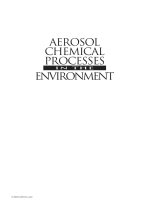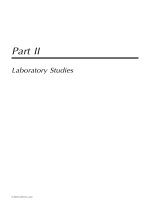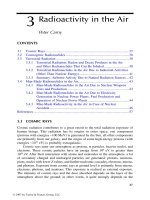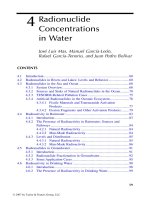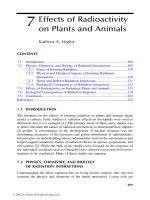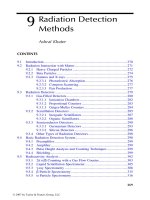Nanotechnology and the Environment - Chapter 1 ppt
Bạn đang xem bản rút gọn của tài liệu. Xem và tải ngay bản đầy đủ của tài liệu tại đây (1.06 MB, 19 trang )
© 2009 by Taylor & Francis Group, LLC
Nanotechnology
and the
Environment
60198.indb 1 6/12/08 1:31:28 PM
© 2009 by Taylor & Francis Group, LLC
CRC Press is an imprint of the
Taylor & Francis Group, an informa business
Boca Raton London New York
Nanotechnology
and the
Environment
Kathleen Sellers
Christopher Mackay
Lynn L. Bergeson
Stephen R. Clough
Marilyn Hoyt
Julie Chen
Kim Henry
Jane Hamblen
60198.indb 3 6/12/08 1:31:28 PM
© 2009 by Taylor & Francis Group, LLC
CRC Press
Taylor & Francis Group
6000 Broken Sound Parkway NW, Suite 300
Boca Raton, FL 33487‑2742
© 2009 by Taylor & Francis Group, LLC
CRC Press is an imprint of Taylor & Francis Group, an Informa business
No claim to original U.S. Government works
Printed in the United States of America on acid‑free paper
10 9 8 7 6 5 4 3 2 1
International Standard Book Number‑13: 978‑1‑4200‑6019‑5 (Hardcover)
This book contains information obtained from authentic and highly regarded sources. Reasonable
efforts have been made to publish reliable data and information, but the author and publisher can‑
not assume responsibility for the validity of all materials or the consequences of their use. The
authors and publishers have attempted to trace the copyright holders of all material reproduced
in this publication and apologize to copyright holders if permission to publish in this form has not
been obtained. If any copyright material has not been acknowledged please write and let us know so
we may rectify in any future reprint.
Except as permitted under U.S. Copyright Law, no part of this book may be reprinted, reproduced,
transmitted, or utilized in any form by any electronic, mechanical, or other means, now known or
hereafter invented, including photocopying, microfilming, and recording, or in any information
storage or retrieval system, without written permission from the publishers.
For permission to photocopy or use material electronically from this work, please access www.copy‑
right.com ( or contact the Copyright Clearance Center, Inc. (CCC), 222
Rosewood Drive, Danvers, MA 01923, 978‑750‑8400. CCC is a not‑for‑profit organization that pro‑
vides licenses and registration for a variety of users. For organizations that have been granted a
photocopy license by the CCC, a separate system of payment has been arranged.
Trademark Notice: Product or corporate names may be trademarks or registered trademarks, and
are used only for identification and explanation without intent to infringe.
Library of Congress Cataloging‑in‑Publication Data
Nanotechnology and the environment / authors, Kathleen Sellers [et al.].
p. cm.
Includes bibliographical references and index.
ISBN 978‑1‑4200‑6019‑5 (alk. paper)
1. Nanotechnology‑‑Environmental aspects. I. Sellers, Kathleen. II. Title.
T174.7.N373193 2008
620’.5‑‑dc22 2008019075
Visit the Taylor & Francis Web site at
and the CRC Press Web site at
60198.indb 4 6/12/08 1:31:28 PM
© 2009 by Taylor & Francis Group, LLC
v
Contents
Acknowledgments vii
About the Authors ix
Chapter 1 Introduction 1
Kathleen Sellers
Chapter 2 Nanoscale Materials: Denition and Properties 11
Kathleen Sellers
Chapter 3 Overview of Manufacturing Processes 33
Julie Chen and Kathleen Sellers
Chapter 4 Developing Environmental Regulations Pertinent to
Nanotechnology 49
Lynn L. Bergeson
Chapter 5 Analyses of Nanoparticles in the Environment 99
Marilyn Hoyt
Chapter 6 Environmental Fate and Transport 123
Chris E. Mackay and Kim M. Henry
Chapter 7 Treatment of Nanoparticles in Wastewater 155
Kim M. Henry and Kathleen Sellers
Chapter 8 The Potential Ecological Hazard of Nanomaterials 169
Stephen R. Clough
Chapter 9 Toxicology and Risk Assessment 193
Chris E. Mackay and Jane Hamblen
60198.indb 5 6/12/08 1:31:29 PM
© 2009 by Taylor & Francis Group, LLC
vi Nanotechnology and the Environment
Chapter 10 Nanoparticle Use in Pollution Control 225
Kathleen Sellers
Chapter 11 Balancing the Risks and Rewards 249
Kathleen Sellers
60198.indb 6 6/12/08 1:31:29 PM
© 2009 by Taylor & Francis Group, LLC
vii
Acknowledgments
The authors gratefully acknowledge the scientists and engineers who reviewed drafts
of this manuscript and provided valuable perspective, including:
Larry S. Andrews, Ph.D., Rohm & Haas
Janis Bunting, General Dynamics
Stefanie Giese-Bogdan, Dr.rer.nat., 3M
Laurie Gneiding, AMEC
Martin P. A. Grifn, Wisconsin Department of Natural Resources
Kimberly A. Groff, Ph.D., AMEC
Richard Johnson, Ph.D., Oregon Health and Science University
Maria Victoria Peeler, Washington State Department of Ecology
Nora Savage, Ph.D., U.S. Environmental Protection Agency
John Schupner, AMEC
Jack Spadaro, Ph.D., AMEC
The authors appreciate the assistance of the following contributors:
Robin Weinbeck, AMEC
Beth Auerbach, Bergeson & Campbell, P.C.
Ira Dassa, Bergeson & Campbell, P.C.
Elizabeth Algeo, AMEC
Kevin Haines, AMEC
Denise Ladebauche, AMEC
Elizabeth Martin, AMEC
Finally, the AMEC team gratefully acknowledges the support for this project
under the AMEC Technical Council’s Research and Development Program.
60198.indb 7 6/12/08 1:31:29 PM
© 2009 by Taylor & Francis Group, LLC
ix
About the Authors
Kathleen Sellers, PE, has worked on developing solutions to a variety of environ-
mental problems during her 20 years of experience. She is particularly intrigued
with exploring emerging environmental issues and their solutions. An environmen-
tal engineer and chemist, Sellers’ work has ranged from analysis and bioassay of
environmental samples through comprehensive eld characterizations, and extended
to treatment process development, permitting, and negotiation of regulatory solu-
tions. Sellers published an engineering textbook entitled Fundamentals of Hazard-
ous Waste Site Remediation (CRC Press/Lewis Publishers, 1999), then edited and
co-authored Technical Brief: Endocrine Disrupting Compounds and Implications
for Wastewater Treatment (Water Environment Research Foundation, 2005) and
Perchlorate: Environmental Problems and Solutions (Taylor & Francis / CRC Press,
2006) before editing and co-writing this book.
Chris E. Mackay, PhD, is an environmental chemist and toxicologist with more
than 10 years of experience conducting site, product, and chemical compliance
assessments. Mackay has worked extensively at the interface of industrial, pharma-
ceutical, and agricultural chemistry and environmental biology. To answer challeng-
ing environmental and toxicology questions, he has constructed statistical models
such as quantitative structure-activity relationships (QSAR) and physiologically
based pharmacokinetics (PBPK), as well as rst principal models for stochastic
competition and thermodynamic energy transfer. These models have been applied
to illustrate and predict not only the transport, fate, and impact of chemical and
biological stresses to human populations and aquatic and terrestrial wildlife, but
also to optimize industrial and agricultural productivity and economy. Along with
providing technical guidance in product and patent development, Mackay has been
involved in designing chemical and toxicological assessments to support product
development and to comply with regulatory requirements under various consumer
and environmental protection statutes in both the United States and Europe. He also
has considerable experience in regulatory chemistry and toxicology.
Lynn L. Bergeson is Managing Director of Bergeson & Campbell, P.C. (B&C), a
Washington, D.C. law rm concentrating on conventional and engineered nanoscale
chemical, pesticide, and other specialty chemical product regulation and approval
matters, domestic and foreign chemical classication, chemical product litigation,
Food and Drug Administration-regulated product approval, and associated business
issues. Bergeson is also president of The Acta Group, L.L.C. and The Acta Group
EU, Ltd., B&C’s consulting afliates, with ofces in Washington, DC and Man-
chester, UK, respectively. She counsels clients on health, safety, science policy, and
related legal and regulatory aspects of traditional domestic chemical regulatory pro-
grams under the Federal Insecticide, Fungicide, and Rodenticide Act (FIFRA) and
60198.indb 9 6/12/08 1:31:29 PM
© 2009 by Taylor & Francis Group, LLC
x Nanotechnology and the Environment
the Toxic Substances Control Act (TSCA), as well as issues pertinent to nanotech-
nology and other emerging transformative technologies.
Stephen R. Clough, PhD, DABT, gr
aduated from the University of Michigan with
an MS in Water Quality (1984) and a PhD in Toxicology (1988). His career experi-
en
ce includes the design and management of mammalian and aquatic toxicology
laboratories for the planning and analysis of safety evaluation studies addressing
both commercial products and industrial waste streams. He was later certied as a
Diplomate by the American Board of Toxicology and has since served more than
20 years as a senior environmental toxicologist. He specializes in benthic bioas
-
se
ssments and the evaluation of point and non-point impacts to the aquatic macro-
in
vertebrate community. Clough has worked at more than 50 hazardous waste sites
where he has evaluated the fate, exposure and ecological effects of a wide range
of toxicants in various types of media, including heavy metals, pesticides, dioxins/
furans, perchlorate, polycyclic aromatic hydrocarbons, and residuals from chemical,
pharmaceutical, pulp/paper/forestry, mining, and automotive industries. He has a
broad understanding of projects and/or regulations that fall under CERCLA, RCRA,
TSCA, FIFRA, and the Clean Water Act, particularly in US EPA Regions I through
IV.
Marilyn Hoyt ha
s more than 25 years of experience in materials science and envi-
ronmental consulting. She has provided chemical measurement support for the
research and development of strategic defense systems as part of a multidisciplinary
team, as well as managed numerous environmental measurement programs. Hoyt
has directed a full service environmental laboratory and has managed studies requir-
in
g original research with data collection and interpretation. She is familiar with the
full array of characterization and instrumental measurement techniques applicable
to nanoparticle measurement, as well as the particular challenges involved in envi-
ro
nmental analyses as compared to laboratory studies.
Julie Chen, PhD, is
currently one of the three co-directors of the University of
Massachusetts Lowell Nanomanufacturing Center. She is responsible for the Nano-
ma
nufacturing Center of Excellence (NCOE), a state-funded center with the mission
of fundamental scientic and applied, industry-collaborative research on environ-
me
ntally benign, commercially viable manufacturing with nanoscale control. Chen
is also the co-director of the Advanced Composite Materials and Textile Research
Laboratory at the University of Massachusetts Lowell, where she is a professor of
mechanical engineering. Chen was the program director of the Materials Processing
and Manufacturing and the Nanomanufacturing Programs in the Division of Design,
Manufacture, and Industrial Innovation at the National Science Foundation from
2002 to 2004. Chen has been on the faculty at Boston University, a NASA-Langley
Summer Faculty Fellow, a visiting researcher at the University of Orleans and Ecole
Nationale Supérieure d’Arts et Métiers (ENSAM-Paris), and an invited participant in
the National Academy of Engineering, Frontiers of Engineering Program (US, 2001,
US-Germany, 2005, and Indo-US, 2006).
60198.indb 10 6/12/08 1:31:30 PM
© 2009 by Taylor & Francis Group, LLC
About The Authors xi
Chen received her PhD, MS, and BS in Mechanical Engineering from MIT. She
has more than 20 years of experience in the mechanical behavior and deformation
of ber structures, ber assemblies, and composite materials, with an emphasis on
composites processing and nanomanufacturing. Examples include analytical model-
ing and novel experimental approaches to electrospinning and controlled patterning
of nanobers, and nanoheaters, as well as forming, energy absorption, and failure of
textile reinforcements for structural (biomedical to automotive) applications.
Kim Henry brings her experience as a hydrogeologist to the fate and transport of
nanoparticles in the environment, and the application of those principles to waste-
water treatment. She has a BA in geological sciences from Harvard University and
an MS in environmental science and engineering from Rice University. Henry has
more than 20 years of experience in characterizing and remediating environmental
contaminants at a variety of sites, including former manufactured gas plants, rail
yards, gasoline stations, bulk storage terminals, chemical reneries, and military
facilities. She has negotiated highly controversial projects with regulatory agencies
and presented the ndings of site investigations at public meetings and press confer-
ences. Henry is intrigued by the concept of science writing, of presenting leading
scientic issues accurately and evocatively to the public. She is also the author of
four children’s books.
Jane Hamblen has more than 28 years of experience in risk assessment, environ-
mental health, and biology. As a senior health scientist, Hamblen is responsible
for managing risk assessment projects and for technical assistance on a variety of
human health projects. Hamblen’s expertise lies in exposure assessment, specializ-
ing in both deterministic and probabilistic analyses. Most recently, she has applied
those skills to the assessment of nanomaterials and the identication of toxic effects
from exposure to nanomaterials. In addition, she has evaluated the public health
impacts associated with PCBs, chlorinated organics, mercury, resorcinol, pesticides,
gasoline spills, and ash generated by power plants. Hamblen has also developed risk-
specic chemical concentrations used to derive clean-up goals, and evaluated public
health risks associated with remedial alternatives. She has co-authored several pub-
lished technical papers, including articles on the use of Monte Carlo methodology
in exposure assessment. Hamblen’s extensive project experience has included human
health risk assessments conducted under CERCLA and RCRA. Her project man-
agement experience ranges from baseline risk assessments to dose reconstruction
projects. She has managed toxic tort cases that allege health effects from chemical
exposure and worked in the area of regulatory compliance for worker and commu-
nity right-to-know legislation.
60198.indb 11 6/12/08 1:31:30 PM
© 2009 by Taylor & Francis Group, LLC
1
1
Introduction
Kathleen Sellers
ARCADIS U.S., Inc.
In early 2007, the United Nations reported that nanotechnology, which then accounted
for approximately 0.1% of the global manufacturing economy, would grow to 14%
of the market by 2014. This m
arket share would correspond to $2.6 trillion in U.S.
dollars [1]. What accounts for this explosive growth? And what does it mean for our
environment? This book provides perspective on those questions based on the cur-
rent state of the science.
Nanotechnology is a eld of applied science concerned with the control of mat-
ter at dimensions of roughly 1 to 100 nanometers (nm) [1]. (1 nm is one-billionth of
a meter.) At the particle size of 1 to 100 nm, nanoscale materials may have differ-
ent molecular organizations and properties than the same chemical substances in a
larger size. Nano-sized chemicals can have different properties due to [2]:
Increased relative surface area per unit mass, which can increase physical
strength and chemical reactivity
In some cases, the dominance of quantum effects at the nanometer size,
which changes basic material properties
These unique properties offer revolutionary means to optimize a variety of prod-
ucts, including electronics, textiles, paintings and coatings, pharmaceuticals, and
personal care products. And these unique properties mean that nanoscale materials
can behave differently in the human body and the environment than the correspond-
ing macro-scale materials.
Similarly, revolutionary developments during the past two centuries offer caution-
ary tales. In the 1800s, gaslights illuminated the Industrial Revolution. Engineers had
devised ways to manufacture gas from the pyrolysis of coal or oil. A hundred years
later, the residuals of that process stained soils bright blue with cyanide compounds
•
•
CONTENTS
1.1 Potential Rewards 2
1.2 Possible Risks and Public Concerns 3
1.3 About This Book 8
References 9
60198.indb 1 6/12/08 1:31:30 PM
© 2009 by Taylor & Francis Group, LLC
2 Nanotechnology and the Environment
and contaminated groundwater with tar residuals. Those historic manufactured gas
plants had come to represent hazardous waste rather than progress. Developments
in the 1900s provide a further example. In 1979, suppliers began adding methyl-
tertiary-butyl ether (MTBE) to gasoline in the United States to replace lead as an
octane enhancer. Later, adding MTBE to gasoline fullled the oxygenate require-
ments in the 1990 Clean Air Act Amendments intended to reduce smog production.
The use of MTBE, however, created another set of environmental problems. Liq-
uid and vapor leaks from underground storage tanks have led to widespread MTBE
contamination in groundwater. The U.S. Geological Survey surveyed water quality
in nearly all 50 states in the 1990s. Of the 4023 groundwater samples collected, 10%
contained detectable MTBE at an average concentration of 280 micrograms per liter
(µg/L) [3], well above the U.S. Environmental Protection Agency’s Health Advisory
of 20 to 40 µg/L in drinking water [4]. These examples illustrate the unintended
consequences that can result from rapid industrial progress.
1.1 POTENTIAL REWARDS
Nanotechnology offers the potential for tantalizing rewards. Amid the hyperbole
and hype, many experts believe that nanotechnology may offer substantial advan-
tages. Consider the following examples [2, 5, 6]:
Energy savings. The U.S. Environmental Protection Agency (U.S. EPA)
has cited one estimate that the use of nanotechnology could reduce the
energy consumption in the U.S. by more than 14% [5]. For example, the
use of nanotechnology-based materials such as lightweight composites and
thinner paint coatings can reduce the weight of airplanes and automobiles,
and thus their fuel usage. Solid-state lighting may use energy more ef-
ciently than conventional lighting. Fuel additives, such as cerium oxide,
may increase diesel fuel efciency.
Alternative energy supplies. Nanotechnology offers the potential to
decrease the cost of producing solar cells to enable more widespread use of
solar power. Advances in battery manufacturing using nanotechnology may
allow for more widespread use of electric vehicles. Finally, with respect to
hydrogen fuel cells, nanotechnology can provide more efcient fuel storage
methods and improve efciency.
Efcient use of raw materials. Nanostructured catalysts may decrease the
mass of catalysts, particularly platinum, used in some applications. The
use of highly effective nano-sized catalysts also can increase production
and decrease waste generation. Nanoscale zeolite catalysts, for example,
are used now in petroleum cracking. Some nanomaterials may provide sub-
stitutes for toxic materials; for example, nanotechnology-based solders can
replace lead-based solders.
Environmental protection. Engineers use nanomaterials in wastewater treatment
and environmental remediation, as described later in this book. Researchers
•
•
•
•
60198.indb 2 6/12/08 1:31:31 PM
© 2009 by Taylor & Francis Group, LLC
Introduction 3
also are studying the use of nanotechnology to treat air pollution. Finally, sen-
sors based on nanotechnology can detect some chemical contaminants.
Agricultural applications. Increased biological efciency could dimin-
ish the amount of pesticides being applied. Similarly, nanodevices used
for “smart” treatment delivery systems hold promise. Smart eld systems
detect, locate, and report/apply, as needed, pesticides and fertilizers prior
to the onset of symptoms. Nanoparticle delivery systems, including nano-
capsules, nanocontainers, and nanocages, could replace conventional emul-
siable concentrates, thus reducing organic solvent content in agricultural
formulations, and enhancing dispersity, wettability, and the penetration
strength of the droplets. Enhanced use of smart systems also could dimin-
ish runoff
a
nd avert unwanted movement of pesticides.
Medical breakthroughs. Nanotechnology is used to create articial bone
and may be used in other prosthetic devices in the future. Researchers are
studying ways to use nanomaterials in medical imaging and for targeted
drug delivery. Probes based on nanotechnology can detect and monitor
changes within cells without destroying them.
This range of potential benets illustrates why so many are excited about the prom-
ise of nanotechnology and its potential economic importance.
1.2 POSSIBLE RISKS AND PUBLIC CONCERNS
The nanotechnology revolution also can present risks. The words of some of the
stakeholders, beginning with a prominent proponent of nanotechnology, illustrate a
range of views regarding potential risks.
“The state of knowledge with respect to the actual risks of nanotechnology
is incomplete.” — United States President’s Council of Advisors on Science
and Technology, 2005 [7].
“It may be that in most cases nanomaterials will not be of human health or
ecological concern. However, at this point not enough information exists to
assess environmental exposure for most engineered nanomaterials.” — U.S.
EPA, 2007 [8].
“At present, the toxicological and ecotoxicological risks linked to this
expanding technology … cannot be assessed yet. Nanotechnology is mov-
ing increasingly into the center of public attention. However, currently it is
not yet linked to any great degree to concerns about health and the environ-
ment. Over the next few years this could change if the media increasingly
will point at components linked with nanotechnology that are harmful to
health or the environment (cf. also public debate on genetically modied
organisms (GMOs)).” — Federal Institute for Occupational Safety and
•
•
•
•
•
60198.indb 3 6/12/08 1:31:31 PM
© 2009 by Taylor & Francis Group, LLC
4 Nanotechnology and the Environment
Health (BAuA), Federal Institute for Risk Assessment (BfR), Federal Envi-
ronment Agency (UBA), Germany,
2006 [9].
“Knowing the basics about the dangers of new materials is a prerequisite
for effective environmental responsibility. With cause for concern, and with
the precautionary principle applied, these materials should be considered
hazardous until shown otherwise.”
— Greenpeace Environmental Trust,
2003 [
10].
As nanotechnology penetrates the marketplace and receives some press cov-
er
age (Figure 1.1
*
[11, 12]), the public is just beginning to develop opinions about
nanotechnology. Those opinions will shape the market for consumer goods contain-
in
g nanotechnology. They may affect the concerns of workers who manufacture or
incorporate nanomaterials into commercial products. Finally, public opinion inu-
en
ces the development of regulations. Given the possible weight and effects of public
opinions, they are worth examining in this Introduction.
Public surveys between 2003 and 2007 showed some common themes and some
different perceptions regarding nanotechnology around the world. Table 1.1 shows
the results of six surveys of people in the U.S., Great Britain, and Japan between
2003 and 2007. This compilation is not a meta-survey or statistical analysis of the
aggregated data, but a summary of some of the key ndings of these six surveys.
In general, many people knew little to nothing about nanotechnology. The level
of knowledge varied: between approximately 20 and 46% of respondents to vari
-
ou
s U.S. surveys had some familiarity with nanotechnology, as did 26% of survey
respondents in Great Britain and 55% in Japan. Many survey respondents distrusted
the ability of the government or corporations to manage nanotechnology wisely.
Condence in the benets of nanotechnology generally increased with knowledge.
In seeming contrast to the public’s relatively limited knowledge of nanotechnol
-
og
y, between mid-2006 and mid-2007 the number of commercially available prod-
uct
s containing nanotechnology more than doubled [13]. The prex “nano” or key
words such as “micronized” featured prominently in some marketing materials, sug-
ge
sting that consumers may favor products with the cachet of nanotechnology — or
at
a
ny rate, that advertisers believe they will.
In the early years of the nanotechnology revolution, then, regulators and non
-
go
vernmental organizations (NGOs) acknowledge the lack of information on the
risks of nanotechnology. Surveys have shown that much of the public is unfamiliar
with nanotechnology. Despite this limited knowledge, survey respondents believed
that nanotechnology offers potential risks and rewards. Absent specic knowledge,
* Figure 1.1 shows the results of two literature searches that illustrate the increase in the availability of
information regarding nanotechnology. A search of the NewsBank database [11] represents informa-
tion available to the general public. NewsBank incorporates information from 27 news magazines,
ranging from People weekly to Popular Science. Figure 1.1 shows the results of a keyword search of
NewsBank on “nanotechnology” performed on June 30, 2007. A similar search performed in Aca-
demic ASAP™ on InfoTrac Web [12] shows the increase in technical publications. The Academic
ASAP database includes more than 14 million articles from academic journals (e.g., Journal of the
American Chemical Society), magazines (e.g., Chemical Week), and news (e.g., Pesticide and Chemi-
cal News). Values for 2007 in Figure 1.1 were estimated by doubling the numbers of articles published
between January 1 and June 30, 2007.
•
60198.indb 4 6/12/08 1:31:31 PM
© 2009 by Taylor & Francis Group, LLC
Introduction 5
people can speculate about doomsday scenarios. Once provided with information,
citizen groups in one recent study believed strongly that the public should be provided
more information and heard in governmental decision making. Risk communication
by government agencies, NGOs, and corporations engaged in nanotechnology, will
help shape the public’s opinions as they evolve. Those opinions, in turn, will inu-
ence the marketplace and regulatory developments. For now, public concerns over
1997 1998 1999 2000 2001 2002 2003 2004 2005 2006 2007
1997 1998 1999 2000 2001 2002 2003 2004 2005 2006 2007
1400
1200
1000
800
600
400
200
0
Articles in Academic Journals
140
120
100
80
60
40
20
0
Articles in News Magazines
FIGURE 1.1 Articles in news magazines and academic journals regarding “nanotechnol-
ogy,” 1997–2007 [11, 12].
60198.indb 5 6/12/08 1:31:42 PM
© 2009 by Taylor & Francis Group, LLC
6 Nanotechnology and the Environment
TABLE 1.1
Public Perceptions Regarding Nanotechnology Based on Opinion Polls
Year
Population
Surveyed
Knowledge of
Nanotechnology Perception of Risk Other Findings Ref.
2003 1005 people
over the age
of 15 in
Great Britain
26% of
respondents had
heard of
nanotechnology
and 19% could
dene the term.
68% of respon-
dents believed
nanotechnology
would improve
life in the future;
13% believed that
the consequences
would depend on
how nanotechnol-
ogy was used.
In subsequent workshops
with 50 participants in
urban areas, researchers
further explored
perceptions. Participants
perceived the benets
might include medical
breakthroughs and other
enhancements to the
quality of life, and hoped
for unforeseeable
benets. Concerns
included social
justice,
nancial implications,
long-term side effects,
whether nanotechnolo-
gies and devices would
work as anticipated, and
whether nanotechnolo-
gies could be controlled.
[18]
2004 1011 Japanese
adults in the
Tokyo area
About 55% of
those respon-
dents had heard
of nanotechnol-
ogy either
frequently or
from time to
time.
Half of those
surveyed believed
that nanotechnol-
ogy would
improve their lives
in the next 20
years.
88% thought positively
about nanotechnology’s
benet to society, but
55% were concerned that
the advancement of
nanotechnology could
present risks to safety,
unexpected outcomes, or
moral issues. “[T]he level
of trust in scientists in
terms of the nanotechnol-
ogy-related information is
the highest (54%) among
NGO, Industry,
government, TV and
other media. And the
government received the
lowest trust (22.5%).”
[19]
60198.indb 6 6/12/08 1:31:42 PM
© 2009 by Taylor & Francis Group, LLC
Introduction 7
TABLE 1.1 (CONTINUED)
Public Perceptions Regarding Nanotechnology Based on Opinion Polls
Year
Population
Surveyed
Knowledge of
Nanotechnology Perception of Risk Other Findings Ref.
2004 1536 adults
randomly
selected
across U.S.
>80% knew little
or nothing about
nanotechnology.
78% thought risks
and benets were
equal or benets
outweighed risks;
those who knew
more about
nanotechnology
believed benets
would outweigh
risks.
Respondents did not trust
business leaders to
minimize nanotechnol-
ogy risks to human
health.
[14]
2005 177 adults in
U.S. focus
groups in
Spokane,
WA,; Dallas,
TX,;
Cleveland,
OH
54% initially
knew almost
nothing about
nanotechnology.
Participants
opinions were
surveyed. They
were presented
with information
about nanotech-
nology, then
surveyed again.
Perceptions that
benets would be
greater than or
equal to risks
increased from
29.4 to 75.6%;
that risks would
exceed benets,
from 5.1 to
15.3%.
(Responses “don’t
know” decreased.)
After being presented with
information on
nanotechnology,
participants held little
trust in government and
industry to protect the
public from the risks of
nanotechnology. Focus
group members also felt
strongly that the public
needed to be better
informed and, the public
should have a role in
decisions about investing
government funds in
research and in managing
the risks of
nanotechnology.
[16]
2006 503
people
across U.S.
Not quantied in
survey.
Consumers are
willing to use
products
containing
nanomaterials
when the potential
benets
are
high,
even if there are
health and safety
risks.
Respondents perceived
that nanotechnology
offered benets on the
order of the benets from
food preservatives and
chemical disinfectants,
albeit at lower risk.
[15]
60198.indb 7 6/12/08 1:31:42 PM
© 2009 by Taylor & Francis Group, LLC
8 Nanotechnology and the Environment
the potential risks of nanotechnology do not seem to be slowing the race to bring
nanotechnology products to the marketplace.
1.3 ABOUT THIS BOOK
This book seeks to demystify, as much as is possible based on the current state of
the science, the occupational and environmental concerns about intentionally manu-
factured nanomaterials. To provide context for that discussion, it begins with an
explanation of nanoscale materials, their properties, and their uses, and describes
the processes used to manufacture nanoscale materials. Subsequent chapters provide
information on possible risks to human health and the environment and on develop-
ing regulations to manage those risks. The penultimate chapter of this book exam-
ines an apparent paradox given concerns over the possible risks of nanotechnology:
the use of nanoscale materials to remediate environmental pollution.
This organizational structure — describing the manufacture of nanoscale mate-
rials, considering their usage, and following those materials through various dis-
charges to points of exposure to gauge the consequences of exposure — parallels
the process of Life Cycle Analysis (LCA). The nal chapter of this book discusses
frameworks such as LCA for evaluating the balance between risk and reward, and
presents brief examples.
This book offers a snapshot of a rapidly developing eld. It presents the current
state of the science and identies critical areas undergoing further research. Even
such fundamentals as denitions, classication schemes, and understanding of the
properties of nanoparticles are evolving. Intensive research into many aspects of
the behavior of nanoparticles in the environment and biological systems continues,
and thus the information presented in this book represents an initial framework for
understanding nanotechnology and the environment. A later edition of this book, if
TABLE 1.1 (CONTINUED)
Public Perceptions Regarding Nanotechnology Based on Opinion Polls
Year
Population
Surveyed
Knowledge of
Nanotechnology Perception of Risk Other Findings Ref.
2007 1014 adults in
U.S.
Approx. 70% had
heard just a little
or nothing at all
about
nanotechnology.
Roughly half of the
respondents were
not sure whether
the benets of
nanotechnology
would outweigh
the risks; those
who had greater
knowledge of
nanotechnology
believed more
strongly in its
benets.
In general, the group of
people with little or no
knowledge about
nanotechnology included
women, older adults,
adults with a high school
degree or less, and adults
with lower incomes.
[17]
60198.indb 8 6/12/08 1:31:43 PM
© 2009 by Taylor & Francis Group, LLC
Introduction 9
written in a few years, would contain much more detail and could address technical
questions more fully. But the community of scientists, engineers, regulators, and the
public cannot wait for the results of mature research; given the possible risks and
rewards of nanotechnology, we must explore what is known about the ramications
of nanotechnology and the environment now.
REFERENCES
1. United Nations Environment Programme. 2007. GEO Year Book 2007: An Overview
of our Changing Environment. Emerging Challenges — Nanotechnology and the
Environment. I
SBN: 978-92-807-2768-9.
(Accessed February 20, 2007)
2. U.S. Environmental Protection Agency. 2007.
Nanotechnology White Paper. EPA/100/
B-07/001. Prepared for the U.S. Environmental Protection Agency by members of the
Nanotechnology Workgroup, a group of EPA’s Science Policy Council: 5, 22–27. http://
www.epa.gov/osa/nanotech.htm. (Accessed February 21, 2007)
3. Thompson, J.A.M., J.W. McKinley, R.C. Harris, et al. 2003. MTBE occurrence in sur
-
face and ground water. In
MTBE Remediation Handbook,
E
d. E.E. Moyer and P.T.
Kostecki, p. 63–70. Amherst Scientic Publishers.
4. U.S. Environmental Protection Agency. 2007. MTBE (methyl-
t-butyl ether) in Drinking
Water. (Accessed
June 27, 2007)
5. The Royal Academy of Engineering, the Royal Society. 2004
. Nanoscience and Nano-
technologies: Opportunities and Uncertainties, Chapter 3. 29 July. al-
soc.ac.uk. (Accessed October 15, 2006)
6. Oakdene Hollins Ltd. 2007. Environmentally Benecial Nanotechnologies: Barriers
and Opportunities. A Report for the Department for Environment, Food, and Rural
Affairs, United Kingdom
(
May).
7. President’s Council of Advisors on Science and Technology (PCAST). 2005. The
National Nanotechnology Initiative at Five Years: Assessment and Recommendations
of the National Nanotechnology Advisory Panel, May 18, 2005. />pcast/pcast.html. (Accessed July 18, 2005)
8. U.S. Environmental Protection Agency. 2007.
Nanotechnology White Paper. E
PA/100/
B-07/001. Prepared for the U.S. Environmental Protection Agency by members of the
Nanotechnology Workgroup, a group of EPA’s Science Policy Council: 14. http://www.
epa.gov/osa/nanotech.htm. (Accessed February 21, 2007)
9. Federal Institute for Occupational Safety and Health (BAuA), Federal Institute for Risk
Assessment (BfR), Federal Environment Agency (UBA), Germany. 2006. Nanotech
-
n
o
logy: Health and Environmental Risks of Nanoparticles — Research strategy. Draft,
August 2006. />-
otechnology/Nanotechnology.html__nnn=true. (Accessed September 26, 2007)
10. Arnall, A.H. 2003. Future Technologies, Today’s Choices Nanotechnology, Articial
Intelligence and Robotics; A Technical, Political and Institutional Map of Emerging
Technologies. A report for the Greenpeace Environmental Trust (July): 7. http://www.
greenpeace.org.uk/MultimediaFiles/Live/FullReport/5886.pdf. (Accessed June 29,
2007)
11. Newsbank, Inc. Keyword search on “nanotechnology.” .
(Accessed June 30, 2007)
12. Expanded Academic ASAP
™ on
I
nfoTrac Web by Thomson Gale. Keyword search on
“nanotechnology.” http://nd.galegroup.com/itx/start.do?prodId=EAIM&userGroupN
ame=mlin_c_grotpl. (Accessed June 30, 2007)
60198.indb 9 6/12/08 1:31:43 PM
© 2009 by Taylor & Francis Group, LLC
10 Nanotechnology and the Environment
13. Woodrow Wilson International Center for Scholars. Project on Emerging Nanotechnol-
og
ies: A Nanotechnology Consumer Products Inventory. otechproject.
org/index.php?id=44&action=intro. (Accessed June 27, 2007)
14. Cobb, M.D. and J. Macoubrie. 2004. Public Perceptions about Nanotechnology: Risks,
Benets and Trust. />working%20papers/Public%20Perceptions%20about%20Nanotechnology%20-%20Ri
sk
s,%20Benets%20and%20Trust.pdf (Accessed June 29, 2007.) Also published in the
Journal of Nanoparticle Research, 6(4), 395–405.
15. Rice University Center for Biological and Environmental Nanotechnology (CBEN).
2007. Survey Shows Consumers Neutral on Risks, Benets of Nanotechnology. Rice
NSEC EEC-0647452. . (Accessed June 30, 2007)
16. Macoubrie, J. 2005. Informed Public Perceptions of Nanotechnology and Trust in the
Government. Woodrow Wilson International Center for Scholars
P
roject on Emerging
Nanotechnologies. September. . (Accessed June 30, 2007)
17. Peter D. Hart Research Associates, Inc. 2007. Awareness of and Attitudes toward
Nanotechnology and Federal Regulatory Agencies. A Report of Findings Based on a
National Survey among Adults. Conducted on Behalf of: Project on Emerging Nano
-
te
chnologies, The Woodrow Wilson International Center for Scholars. 25 September.
. (Accessed September 28, 2007)
18. The Royal Academy of Engineering, the Royal Society. 2004.
Nanoscience and Nano-
technologies: Opportunities and Uncertainties, Chapter 7. 29 July. al-
soc.ac.uk. (Accessed October 15, 2006)
19. Fujita, Y. and S. Abe. 2005. Perception of Nanotechnology among General Public in
Japan. Nanotechnology Research Institute,
Asia Pacic Nanotech Weekly 4
(
6) http://
www.nanoworld.jp/apnw/articles/library4/pdf/4-6.pdf. (Accessed June 29, 2007)
60198.indb 10 6/12/08 1:31:43 PM
